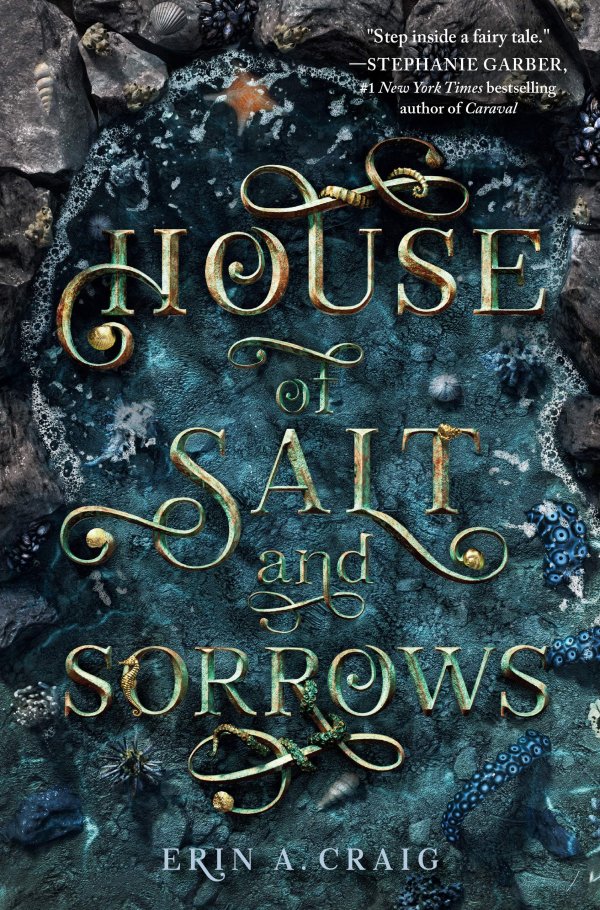 Fairy tale adaptions are a popular subset of YA novels, but not many are based on Rumpelstiltskin. However, Erin Craig has taken that tale and turned it into a gothic flavored thriller in Small Favors.
Fairy tale adaptions are a popular subset of YA novels, but not many are based on Rumpelstiltskin. However, Erin Craig has taken that tale and turned it into a gothic flavored thriller in Small Favors.
Back Cover Blurb
Ellerie Downing is waiting for something to happen. Life in isolated Amity Falls, surrounded by an impenetrable forest, has a predictable sameness. Her days are filled with tending to her family’s beehives, chasing after her sisters, and dreaming of bigger things while her twin, Samuel, is free to roam as he wishes.
Early town settlers fought off monstrous creatures in the woods, and whispers that the creatures still exist keep the Downings and their neighbors from venturing too far. When some townsfolk go missing on a trip to fetch supplies, a heavy unease settles over the Falls.
Strange activities begin to plague the town, and as the seasons change, it’s clear that something is terribly wrong. The creatures are real, and they’re offering to fulfill the residents’ deepest desires, however grand, for just a small favor. These seemingly trifling demands, however, hide sinister intentions. Soon Ellerie finds herself in a race against time to stop Amity Falls, her family, and the boy she loves from going up in flames.
The Review
Life is peaceful and predictable for Ellerie Downing, a farm girl in Amity Falls, a frontier town surrounded by an impenetrable pine forest. Then one summer, all the members of a supply train get slaughtered in the woods. Shortly thereafter, strange occurrences start happening to the populace, and misshapen animals appear in and around the town. After a fire ravages the Downing farm, Ellerie’s father must take her mother to the city for medical treatment, and it’s up to Ellerie to protect what remains of her family and home against the sinister forces threatening Amity Falls.
I reviewed Craig’s previous work House of Salt and Sorrows. If you enjoy her brand of creepy imagery, you’ll probably like Small Favors. The main difference is that in her previous work, most of the ghoulish stuff was limited to the heroine’s hallucinations and nightmares. In Small Favors, multiple characters are beset by disturbing visions, and monstrosities show up in the flesh to horrify everyone in town.
The exact location of the town and time period are never explicitly stated, but I’m guessing it’s somewhere in the American Midwest during the early 1800s. The residents are descended from Puritan-like settlers, and although they are reliant on periodic supply runs for manufactured goods and other necessities, they live for the most part in isolation. No mail. Very few visitors.
So the community slides into a steady decline when their link to the outside world (the supply train) gets broken amid rumors that the forest monsters that once terrorized the original settlers have returned. Those fears are cemented when abnormalities plague their fields and livestock. Craig does an excellent job of inserting horribly mutated versions of things to shake up her characters, then plunging them into hardships to drive them further on edge.
She’s less effective with the infighting among the Amity Falls folks. We can see the deterioration of Ellerie’s relationships with her best friend and twin brother, but not so much for the others. Mainly because there are too many to keep track of. As in House of Salt and Sorrows, most of the cast are a muddle of names without much to distinguish them. The book opens with a list of the “Important Families of the Gathering,” but even with the list (which doesn’t even include all the townsfolk mentioned by name), I still had trouble remembering which character was which.
In terms of the supernatural forces wreaking this havoc, Craig keeps readers guessing as to their true nature and as to which occurrences are their doing and which stem from the townsfolks’ own intent. However, the reveal of the Brotherhood of Light with their trove of knowledge felt a bit too convenient, as did their assumed identities. I’m a nitpick for details, and the Brotherhood seemed overly informed of the Amity Falls situation given how isolated it is. (The next settlement is several days away by horse.) There is one mention of a messenger bird, but no mention of it carrying news or correspondence. Also bothersome is how the town risks another ill-fated supply run right before winter because they are so desperate for supplies, but once spring comes, no one even talks about a supply run.
Ellerie is also really slow to connect the weirdness in town to the handsome, mysterious stranger who won’t tell her his real name. Or give her a straight answer about anything else. In terms of the romance aspect, it is very similar to that in Salt and Sorrows. There are heart-pounding instances with Ellerie’s building attraction to Whitaker, but he walks into the story besotted with her before she lays eyes on him. Given the breadth of his experience before they meet, I find it difficult to believe that he would fall in love simply by looking at Ellerie, engaging though she is.
By the way, the cast includes two Englishmen, and the narrative mentions a French trapper who once lived near Amity Falls, but there is no mention at all of Native Americans.
In Summary
Small Favors is a Gothic thriller set in an isolated 19th-century American town that chronicles the populace’s descent from harmony and order to chaos and hate. There are creepy scenes and visions aplenty as Ellerie first struggles to navigate the bizarre events plaguing her town and then strives to discover who’s behind them. However, she is slow on the uptake regarding her love interest, who’s a little too perfect and innocent for his background. While the novel is a retelling of Rumpelstiltskin, the connection to the original work is very subtle, and if you’re looking for happy endings, this ending is mostly not.
First published at The Fandom Post.

 The Seekers of Genesis: Empyreal Roots is the debut work of author C. J. Walters. Read on for the review.
The Seekers of Genesis: Empyreal Roots is the debut work of author C. J. Walters. Read on for the review. Sara Shepard is a YA author best known for Pretty Little Liars. Recently she collaborated with 17-year-old actor Lilia Buckingham, and the result is the YA suspense novel Influence. Read on for the review.
Sara Shepard is a YA author best known for Pretty Little Liars. Recently she collaborated with 17-year-old actor Lilia Buckingham, and the result is the YA suspense novel Influence. Read on for the review. A primary criticism of the We Need Diverse Books movement is how books are populated by overwhelmingly white casts. This is definitely not the case in Namina Forna’s YA fantasy The Gilded Ones. Read on for the review.
A primary criticism of the We Need Diverse Books movement is how books are populated by overwhelmingly white casts. This is definitely not the case in Namina Forna’s YA fantasy The Gilded Ones. Read on for the review. Despite the declining number monarchies, tales of lost or hidden royals continue to fascinate people across cultures. Now Rebecca McLaughlin presents another story about a blue blood among the masses with her YA fantasy Nameless Queen. Read on for the review.
Despite the declining number monarchies, tales of lost or hidden royals continue to fascinate people across cultures. Now Rebecca McLaughlin presents another story about a blue blood among the masses with her YA fantasy Nameless Queen. Read on for the review. Despite the fact that the United States began by rebelling against a monarchy, many Americans retain a romantic view of royalty. That’s the target audience of American Royals. Read on for the review.
Despite the fact that the United States began by rebelling against a monarchy, many Americans retain a romantic view of royalty. That’s the target audience of American Royals. Read on for the review. It’s rare to find an adult title that’s beautifully written and carries a message of hope, but The Miracles of the Namiya General Store has got both qualities. Read on for the review.
It’s rare to find an adult title that’s beautifully written and carries a message of hope, but The Miracles of the Namiya General Store has got both qualities. Read on for the review. A lot of retellings recast females in much more active roles than they originally had. Kiersten White does this with the Arthurian legends in The Guinevere Deception. Read on for the review.
A lot of retellings recast females in much more active roles than they originally had. Kiersten White does this with the Arthurian legends in The Guinevere Deception. Read on for the review. Fairy tale adaptions are a popular subset of YA novels, but not many are based on The Twelve Dancing Princess. However, Erin Craig has taken that lesser known tale and combined it with gothic flavored horror in House of Salt and Sorrows.
Fairy tale adaptions are a popular subset of YA novels, but not many are based on The Twelve Dancing Princess. However, Erin Craig has taken that lesser known tale and combined it with gothic flavored horror in House of Salt and Sorrows. wizards as central characters, but how about a tailor with a magical touch? Elizabeth Lim presents the tale of a girl tasked to create three mythical gowns in her debut novel Spin the Dawn.
wizards as central characters, but how about a tailor with a magical touch? Elizabeth Lim presents the tale of a girl tasked to create three mythical gowns in her debut novel Spin the Dawn.